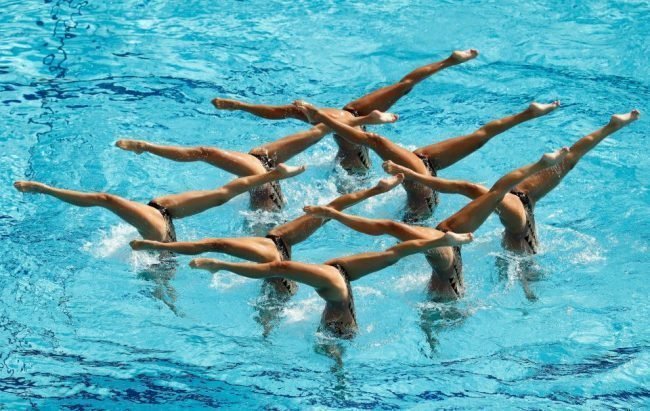Synchronized swimming (new FINA-approved name – artistic swimming) is a water sport associated with the performance of various figures in the water to the music. Synchronized (artistic) swimming is one of the most sophisticated and elegant of all sports.
Synchronized (artistic) swimming was considered an exclusively female sport, but at first men were engaged in it, they also participated in the first competitions. Now men are returning to synchronized swimming again – there are no men’s competitions in the Olympic program yet, but men are already competing at the World Championships.
In order to practice this sport, you need to have not only endurance, but also flexibility and exceptional breath control. It is a technically difficult type of swimming and one of the most difficult Olympic sports. Synchronized (artistic) swimming has been an Olympic sport since 1984.
Synchronized swimming: history and technique
Synchronized swimming is called the most graceful and elegant Olympic sport for a reason. Synchronized swimmers’ performances are always pleasing to the eye with their figures and choreographic skills. In addition, a few years ago, this discipline was renamed Artistic Swimming by FINA to more accurately reflect the essence of the competition. While we will gradually get used to it, we can tell you more about this sport.

From the history of synchronized swimming
It all started with the so-called “water ballet”, which gradually gained more and more popularity in Canada at the beginning of the twentieth century. Soon this direction moved to the USA, after which it received the status of an independent sport. The first international championship was held in France in 1952. In the Olympic program, synchronized swimming appeared in 1984.
Synchronized swimming technique
The essence of artistic swimming lies in the team performance of choreographic sketches and compositions in the upper layers of the water and above the surface. All movements must be coordinated with the playing music. Synchronized swimmers perform either as a duet or as an eight. Sometimes, special competition regulations allow a different number (ten).
Performances are divided into two programs – technical and free, which are evaluated by judges according to different criteria, approximately like in figure skating. Arbitration consists of ten people located on opposite sides of the pool. The free program is the most colorful spectacle, built on the artistic talent of the team’s coach. He himself selects and musical accompaniment. The performance lasts 4 minutes in duets and 5 minutes in teams.
What should athletes be able to do?
Athletes, in addition to grace, require superbly organized work with breathing, as well as good physical shape and endurance. Imagine how much strength, skill and coordination it takes to keep your partner above the water with outstretched arms. Some programs provide for a long stay of the athlete under water, sometimes upside down. This is top notch craftsmanship.
The rhythm of breathing and all movements must be absolutely coordinated with the tempo of the playing music. All this is achieved through numerous trainings and rehearsals. Only in this case, spectators and fans will be able to get real pleasure from the performance, and the athletes will be highly appreciated by the jury.
In order to prevent water from entering the nose during the performance, nose clips are used in synchronized swimming.
Synchronized swimming: figures

According to the international classification, figures in synchronized swimming are divided into five groups (“ballet position”, “dolphin”, “counter-dolphin”, “somersault” and “diverse”) and are indicated by numbers. For the figures of the “ballet position” group, a leg raised vertically above the surface of the water with a drawn toe is characteristic.
In the starting position, the athlete lies on her back on the surface of the water with an absolutely extended body position. Individual figures are performed by rotation around the longitudinal and transverse axes, as well as various forms of immersions and ascents.
For groups “dolphin” and “counterdolphin” it is typical to swim in a circle, which begins with a dive in the position on the back and ends with an ascent in the same position. In the figures of the “dolphin” group, the circle swims head first, the “counter-dolphin” group – feet first.
Slight bending of one leg at the knee, pulling back of the toes, rotation around the longitudinal axis, continuous swimming of two circles to perform the figure of a horizontally lying eight, simultaneous swimming of the circle by two or more participants – all these are significant possibilities for varying the figures of these groups.
While in other sports, at least one full turn is required to perform a somersault, in figure swimming a quarter turn is regarded as a somersault. So, for example, the first figure in the “somersault” group “barracuda” consists of diving head first in the supine position, followed by the removal of the legs bent at the hip joints above the surface of the water.
This group also includes rotations performed with the legs bent at the knees and hip joints (in the “group” position) or only in the hip joints. Directly adjacent to the rotations is a movement that ensures the removal of the legs vertically above the surface of the water.
However, the legs should not “freeze” in this position above the water. The diverse group includes all other forms of movement, which consist of handstands, flips, spins on the surface of the water, and figures.
